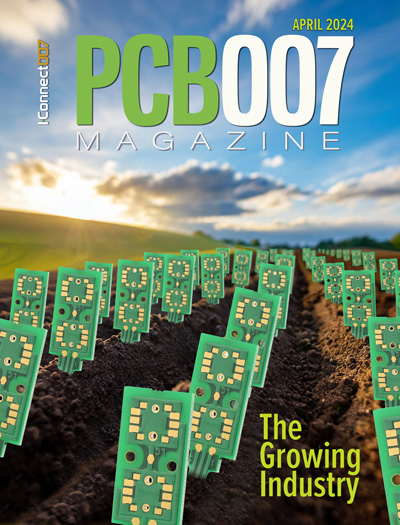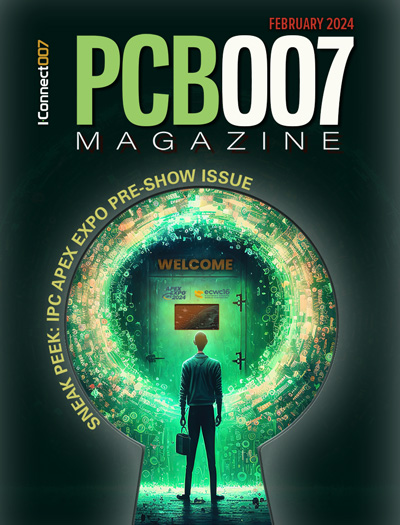-

- News
- Books
Featured Books
- pcb007 Magazine
Latest Issues
Current Issue
The Growing Industry
In this issue of PCB007 Magazine, we talk with leading economic experts, advocacy specialists in Washington, D.C., and PCB company leadership to get a well-rounded picture of what’s happening in the industry today. Don’t miss it.

The Sustainability Issue
Sustainability is one of the most widely used terms in business today, especially for electronics and manufacturing but what does it mean to you? We explore the environmental, business, and economic impacts.

The Fabricator’s Guide to IPC APEX EXPO
This issue previews many of the important events taking place at this year's show and highlights some changes and opportunities. So, buckle up. We are counting down to IPC APEX EXPO 2024.
- Articles
- Columns
Search Console
- Links
- Events
||| MENU - pcb007 Magazine
CES 2016 Wrap-Up, Part 1
January 12, 2016 | Dan Feinberg, Technology Editor, I-Connect007Estimated reading time: 9 minutes
CES 2016 is now history and most of us are home, or at our next port-of-call. I have seen various attendance numbers but it’s somewhere in the range of 175,000; it was busy, crowded and impossible to see everything.
In my opinion the main categories this year were:
Autonomous vehicles stole the show. We covered the NVIDIA announcements and the commitment by Volvo to use the new NVIDIA supercomputer in a cigar box for their first autonomous auto offering. Even though it has not been announced, we saw evidence that the NVIDIA PX-2 unit is going to be used in many auto offerings over the next few years. We will continue to cover self-driving cars.
Drones continue to generate a great deal of attention. There were even more models offered by even more companies, but there is a back story that has little to do with the hardware—more on that in my next article.
Of course there is the IoT, the Internet of Things. It is now possible to connect anything and everything, from your underwear to your toothbrush, to your music library and your TV or phone. While there are many new and upcoming connected things, the absolute leaders of the pack are health and fitness devices.
Also ascending in popularity, offerings and uses is virtual and augmented reality. The first commercial units are now available, and a number of concept and pre-commercial units were shown. My opinion is that virtual reality will be popular for gaming and for entertainment, but I predict that the uses for augmented reality will greatly exceed those of VR. AR will be useful for entertainment, and also be widely used for industrial, communications, demonstrations and much more.
3D printing has made great strides lately. This year, we went back to see the folks at Voxel 8. They have made a great deal of progress, especially in the area we are interested in, which is the use of 3D printing to manufacture PCBs. Overall, they have gone from a startup company that had just received its first significant funding to a growing, maturing company that is gaining market share in an exploding industry segment in just one year. (Our interview with one of the founders of Voxel 8 should be live in a week or so.)
Page 1 of 4
Suggested Items
Mycronic Releases Interim Report January–March 2024
04/18/2024 | MycronicNet sales increased 39 percent to SEK 1,692 (1,219) million. Based on constant exchange rates, net sales increased 42 percent.
NCAB Appoints Tim Benjamin as New CFO
04/15/2024 | NCAB GroupNCAB Group has appointed Tim Benjamin as its new CFO. Tim has a long and broad experience of managerial business finance roles, including M&A and IT.
TT Electronics Awarded Contract with Kongsberg Defence and Aerospace
04/11/2024 | TT ElectronicsTT Electronics, a leading provider of global manufacturing solutions and engineered technologies, announced today that its Fairford UK business has been awarded a new contract with long-standing customer Kongsberg Defence and Aerospace (Kongsberg) for the production of complex cable harness solutions.
IPC APEX EXPO 2024: There’s an App for That
04/03/2024 | Kim DiCianni, IPCWith so many things to do at a large trade show and conference like IPC APEX EXPO, you cannot possibly take every class, attend every talk, or see every vendor on your list. But you can plan your days and maximize your time with the IPC APEX EXPO mobile app. The app allows you to easily view the show’s daily agenda, keynote speakers, the conference and professional development schedules, and, of course, flag and make notes on exhibitors.
It’s Only Common Sense: When Your Company Starts Running Out of Popcorn
04/01/2024 | Dan Beaulieu -- Column: It's Only Common SenseCompanies, like people, get tired. I have seen companies just lose their focus, their “raison d’etre,” and just, well, fade away. More than once, I have sat in the office of a company owner, trying to console him while he asks me to “get him out of there.” Owners just get tired of the daily grind. They want off the treadmill of the constant juggling of people, strategies, customers, and, of course, cash flow.


